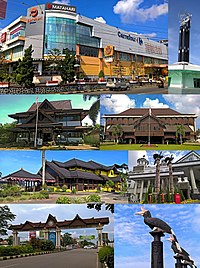
Photo from wikipedia
The presence of microplastics (MPs) in marine environments has become increasingly apparent. Owing to the lack of effective solid waste management, Indonesia is the second largest producer of ocean plastic… Click to show full abstract
The presence of microplastics (MPs) in marine environments has become increasingly apparent. Owing to the lack of effective solid waste management, Indonesia is the second largest producer of ocean plastic waste after China. Currently, information about pollution of MPs in the sediments of East Surabaya, Indonesia, is not available, and this issue is addressed in this study for the first time. Sediment samples were collected from 16 sampling sites along urban and mangrove coastal areas. MPs were observed in most of the sampling sites, with abundances ranging from ND (not detected) to 598 items/kg. MP shapes constituted fragments (30%), foam (28%), granules (22%), and fibers (20%). The 500–1000 µm fraction was the dominant size of MPs. Polypropylene was the major polymer constituent, followed by high-density polyethylene and polyethylene. Findings from Spearman’s correlation coefficients, principal component analysis, and hierarchical cluster analysis reveal that the spatial pattern of MPs is closely related to coastal characteristics and population density. MPs in different coastal regions were assessed by the polymer risk index. Results reveal that coastal areas in the Bulak district exhibit the highest risk. Our results confirm the prevalence of MPs as anthropogenic pollutants in East Surabaya and highlight the importance of management action and education on environmental protection for the mitigation of MP pollution.
Journal Title: International Journal of Environmental Research and Public Health
Year Published: 2022
Link to full text (if available)
Share on Social Media: Sign Up to like & get
recommendations!